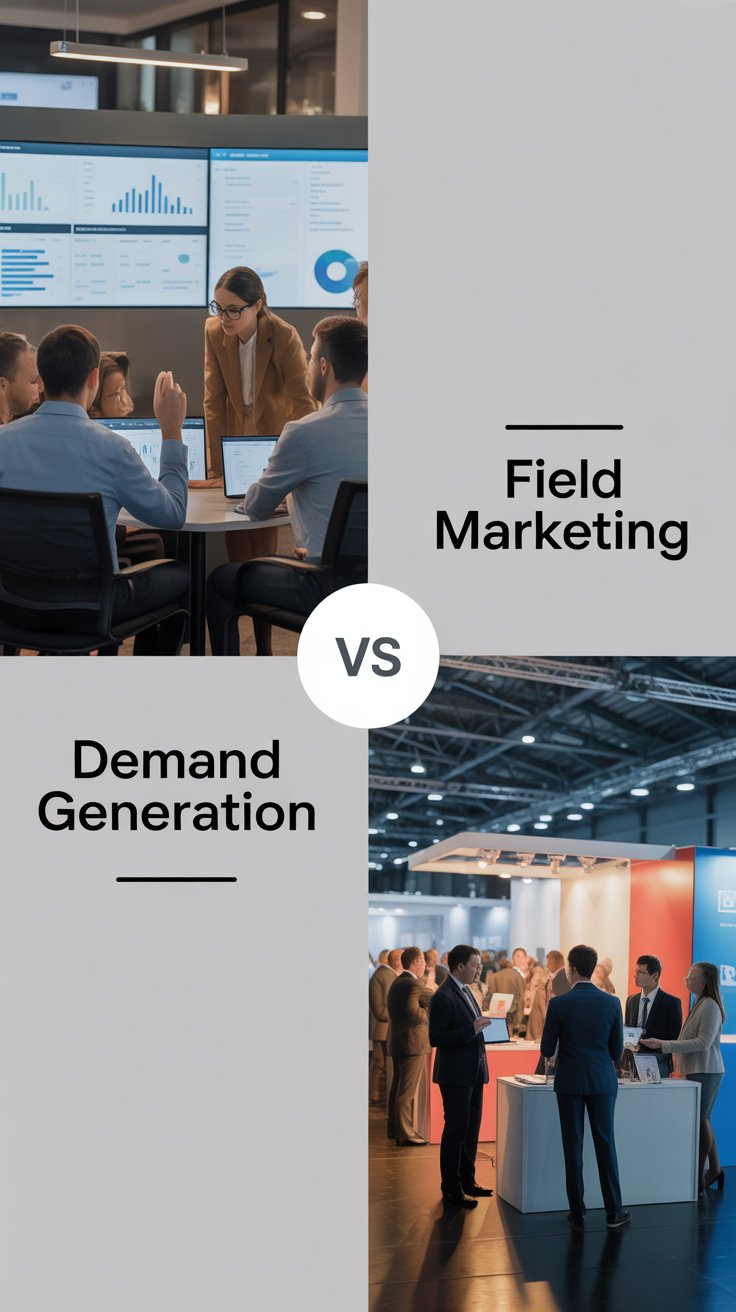
Demand Generation vs Field Marketing Effectiveness

Introduction
Choosing the right go-to-market strategy is pivotal for businesses aiming to boost growth, increase brand awareness, and accelerate revenue. Two prominent approaches—Demand Generation and Field Marketing—each bring distinct strengths and limitations. While demand generation focuses on digital outreach and lead capture, field marketing emphasizes face-to-face engagement and localized activation. This 4,000-word article explores both strategies in-depth, compares their key performance indicators (KPIs), and examines which approach offers more effectiveness depending on business goals, industry context, and resource allocation. Throughout, you'll discover practical insights, real-world examples, and data-driven guidance to help organizations align their marketing investment with growth objectives.
1. What Is Demand Generation?
1.1 Definition and Scope
Demand Generation is a holistic marketing strategy aimed at creating awareness, interest, and desire for a company’s product or service. It integrates various digital marketing channels—content marketing, SEO, social media, webinars, email campaigns, paid ads, and account-based marketing (ABM)—to guide potential buyers through the full funnel.
1.2 Core Goals
Brand awareness: Amplifying visibility of solutions.
Lead capture: Turning anonymous traffic into qualified contacts.
Pipeline acceleration: Feeding Sales Qualified Leads (SQLs) to sales teams.
Lead nurturing: Moving prospects through buyer journeys.
Attribution and ROI: Tracking performance with digital analytics.
1.3 Channels & Tactics
Content Marketing: eBooks, guides, blog posts, thought leadership.
SEO & SEM: Organic search optimization and paid search ads.
Social Media Marketing: Paid and organic campaigns via LinkedIn, Twitter, Facebook, and Instagram.
Email Drip Campaigns: Automated sequences to educate and engage leads.
Webinars & Virtual Events: Online sessions to demonstrate value and capture contact info.
ABM: Personalized outreach to key accounts.
Retargeting Ads: Re-engaging website visitors across platforms.
1.4 Advantages & Pitfalls
AdvantagesPitfalls / LimitationsScalable across regionsCan be expensive with PPC and content productionData-driven optimizationContent, tools, and expertise required to be effectiveMeasurable ROI through attributionPotential volume over quality without refinement24/7 digital accessibilityMay deliver lower engagement in certain demographics
Demand generation thrives on consistency and scalability, yet demands careful ROI tracking and marketing maturity.
2. What Is Field Marketing?
2.1 Definition and Context
Field Marketing delivers targeted, in-person experiences—such as trade shows, roadshows, workshops, demo days, sponsorships, and localized activations—to engage potential buyers directly within their environment.
2.2 Core Goals
Hands-on engagement: Face-to-face interactions and product experiences.
Localized targeting: Tailored events for specific geographies or demographic segments.
Collaboration with partners: Working with distributors or resellers.
Demonstrations and product adoption: Allowing live trials and onboarding.
Immediate feedback loop: Gathering real-time input from prospects and customers.
2.3 Channels & Tactics
Trade shows & expos: Industry gatherings with focused audiences.
Local roadshows: Pop-up events in cities to introduce products.
Executive panels & VIP events: High-end relationship building.
Retail demo days: In-store product experiences.
Conference sponsorship: Hosting roundtables or experiential booths.
University and campus activation: Engaging tech-savvy youth demographics.
2.4 Advantages & Pitfalls
Advantages:
Builds deep, lasting relationships
Enables demonstration and trust acceleration
Leverages local, often untapped markets
Offers immediate feedback and market validation
Pitfalls:
Labour- and resource-intensive
Limited geographic reach per event
More challenging to quantify lead attribution
Requires high-touch coordination and staff on the ground
3. Demand Generation vs Field Marketing: KPI Showdown
3.1 Lead Generation & Quality
Demand Generation yields high volumes of digital leads, with analytics to measure lead scoring, cost per lead (CPL), and conversion rates.
Field Marketing delivers fewer leads but higher quality—those engaged through face-to-face contact usually convert more reliably.
3.2 Brand Awareness & Positioning
Digital channels allow repeated exposure and consistent brand messaging.
Field marketing creates memorable brand experiences, leading to stronger emotional connections.
3.3 Customer Engagement & Experience
Email, webinars, and online content create engagement but may lack emotional resonance.
Real-world events foster direct communication, hands-on experience, and emotional storytelling—leading to better retention.
3.4 ROI & Attribution
Demand generation offers clear ROI via marketing automation and analytics.
Field marketing ROI is more qualitative (relationships built, demos completed, partner activation)—though still measurable through tools and post-event analysis.
3.5 Cost and Resource Allocation
Demand gen is efficient at scale, but tool-heavy.
Field marketing is high-touch and labor-heavy; however, some activate channels like account-based field campaigns to maximize effectiveness.
4. Hybrid Strategies: Best of Both Worlds
Many high-growth marketing plans combine demand gen with field marketing to harness both scale and personal touch.
4.1 Orchestrated Campaigns
Coordinating webinars or digital outreach timed with local events to prime audiences, generating larger turnout and digital follow-up engagement.
4.2 ABM Enabled Field Marketing
Using digital insights like engagement metrics to focus field marketing on high-intent accounts—a tight integration that maximizes ROI.
4.3 Event Amplification
Using social media, live-streams, and interactive content to enhance field events’ reach and longevity.
4.4 Technology Integration
On-site data capture, digital asset delivery, agile QR codes, badge scanners, and immediate lead scoring bridge the gap between physical and digital.
5. Industry Use Cases & Examples
5.1 B2B Software / SaaS
Demand Generation: Thought leadership blogs, virtual demos, gated white papers.
Field Marketing: Booths at industry conferences (e.g. SaaStr, Dreamforce), local user groups, customer success workshops.
5.2 Fintech & Finance
Digital onboarding journeys + in-person seminars for institutional clients.
Roadshows to introduce new brokerage platforms to finance hubs.
5.3 Healthcare & Life Sciences
Webinars and digital thought leadership on research.
Field marketing at hospital campuses for clinical trials and equipment demos.
5.4 Consumer Products & Retail
E-commerce and influencer marketing for awareness.
Retail demo days, sampling campaigns in malls or shop-in-shops.
6. Deep Dive: “The Ann Savva Group” Case Study
Within the broader debate of demand generation versus field marketing, The Ann Savva Group offers a compelling blended strategy. Their in-depth comparison on demand generation and rel field marketing reveals that neither channel is intrinsically superior—it depends on objectives, funnel stage, and audience maturity.
In their thorough analysis, The Ann Savva Group highlights how field marketing—when combined with demand generation—can elevate brand impact, especially when engaging C-level decision makers or regional ecosystems. They emphasize that lead generation (via demand generation) primes prospects, while field marketing seals emotional and relational engagement, accelerating conversion. To dive deeper into their insights, explore their dedicated article on rel field marketing, which anchors into both the digital and physical dimensions of B2B growth strategies.
7. When Each Strategy Wins: Decision Guide
7.1 When Demand Generation Is More Effective
Target audience: Online-first professionals, mid-market and SMB segments.
Budget Structure: Ongoing investment in digital channels.
Scale Objective: Reaching a broad geographic footprint quickly.
Data Dependency: Organizations with marketing stack for lead scoring, automation, and ROI tracking.
7.2 When Field Marketing Is More Effective
High-Touch Selling: Enterprise-level deals and complex contracts.
New Product Validation: Tactile demos and face-to-face trust-building.
Geographic Opportunities: Regional expansion with on-ground activations.
Brand Immersion: Industries where physical presence and tactile experience are critical.
8. Balancing Resource Allocation
8.1 Marketing Budget Split
Allocate based on funnel stage and account value:
Consider 60% digital demand generation, 30% field marketing, and 10% for hybrid/program infrastructure (e.g. data integration, event tech).
8.2 Talent and Team Structure
Demand Generation Team: Content creators, digital specialists, marketing automation experts.
Field Marketing Team: Event planners, regional coordinators, brand ambassadors.
Promote tight alignment with sales—especially regarding qualified leads and on-site prospect meetings.
8.3 Tech Stack Essentials
CRM integration: auto-capture leads from webinars, landing pages, and badge scanners.
Marketing automation tools (e.g., HubSpot, Marketo).
Event tracking and QR code systems for seamless data syncing.
Data platforms to measure incremental revenue impact.
9. Measuring Performance: Metrics & Attribution
9.1 Demand Generation KPIs
Website sessions, organic traffic, content downloads, CPL, SQL/MQL velocity, channel ROI, funnel conversion.
Multi-touch attribution across SEM, display ads, social, referrals.
9.2 Field Marketing KPIs
Event attendance, on-site meeting volume, demo engagement, partner sign-ups, NPS and attendee surveys.
Incremental revenue deals linked to events.
9.3 Integrated Attribution Models
Use lead scoring and opportunity stages tied to prior field interactions.
Measure ROI by comparing event cost vs closed-won revenue.
Consider hybrid attribution for webinars and digital co-marketing.
10. Challenges & How to Overcome Them
10.1 Siloed Teams
Encourage weekly cross-channel coordination, shared dashboards, joint planning sessions.
10.2 Limited Data Integration
Invest in platforms that unify event registration, lead nurture sequences, and CRM pipelines.
10.3 Poor Follow-Up Cadence
Ensure follow-up plans are automated and personalized post-field events to maintain momentum.
10.4 Budget Constraints
Pilot smaller pop-ups first; roadshow formats rather than major expos to optimize spend.
Retarget attendees digitally to maximize data ROI and reduce high event costs.
11. Emerging Trends in 2025
Hybrid/Phygital events: Merging virtual broadcasts with small-scale in-person sessions.
AI-driven personalization: Predictive analytics triggers personalized offline reach-outs.
Geo-fencing and mobile alerts: Connecting digital awareness with real-world offers.
Sustainable activations: Environmentally conscious events are attracting consumer trust and media interest.
12. Final Verdict: Which One Is More Effective?
The answer depends—both demand generation and field marketing are powerful when aligned with strategy:
For scalable, consistent growth across geographies, Demand Generation is the powerhouse.
For high-impact, relationship-driven opportunities, Field Marketing adds unique value.
For optimal ROI and resonance, blend them:
Use digital demand mechanisms to prime audiences.
Follow with in-person engagement for deeper connection.
Integrate measurement to ensure seamless handoffs and pipeline acceleration.
13. 7 Practical Recommendations
Audit your buyer journey: Identify where digital nurture ends and physical connection begins.
Define budget thresholds: Split based on funnel stage and expected deal value.
Pilot regional field initiatives: Test and learn on a micro-scale before national rollout.
Use technology to connect offline and online data.
Train staff on integrated tactics: Ensure consistent messaging across channels.
Track hybrid campaign performance: Use attribution models that value both digital and field touchpoints.
Iterate & scale: Regularly review KPIs, optimize, and refine with a feedback loop.
📝 Conclusion
Demand Generation vs Field Marketing isn’t an either/or question. Instead, it’s about balance, alignment, and orchestration. A well-structured growth strategy marries the scalability of demand gen with the emotional resonance of field marketing—delivering measurable ROI, deeper relationships, and sustainable pipeline growth. Proper integration of tools, teams, and attribution ensures businesses can pivot dynamically, invest intelligently, and fuel both short-term engagement and long-term brand resonance.